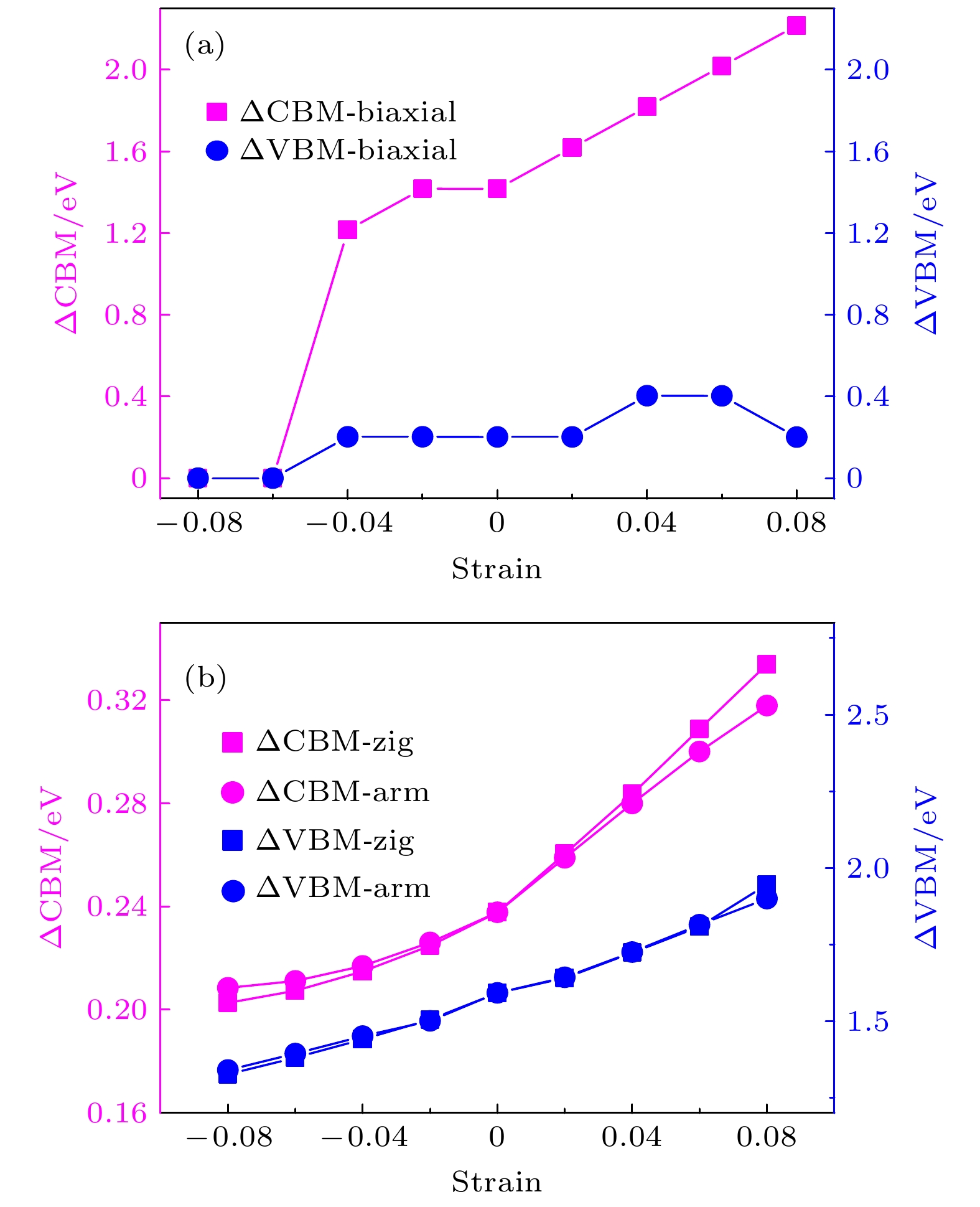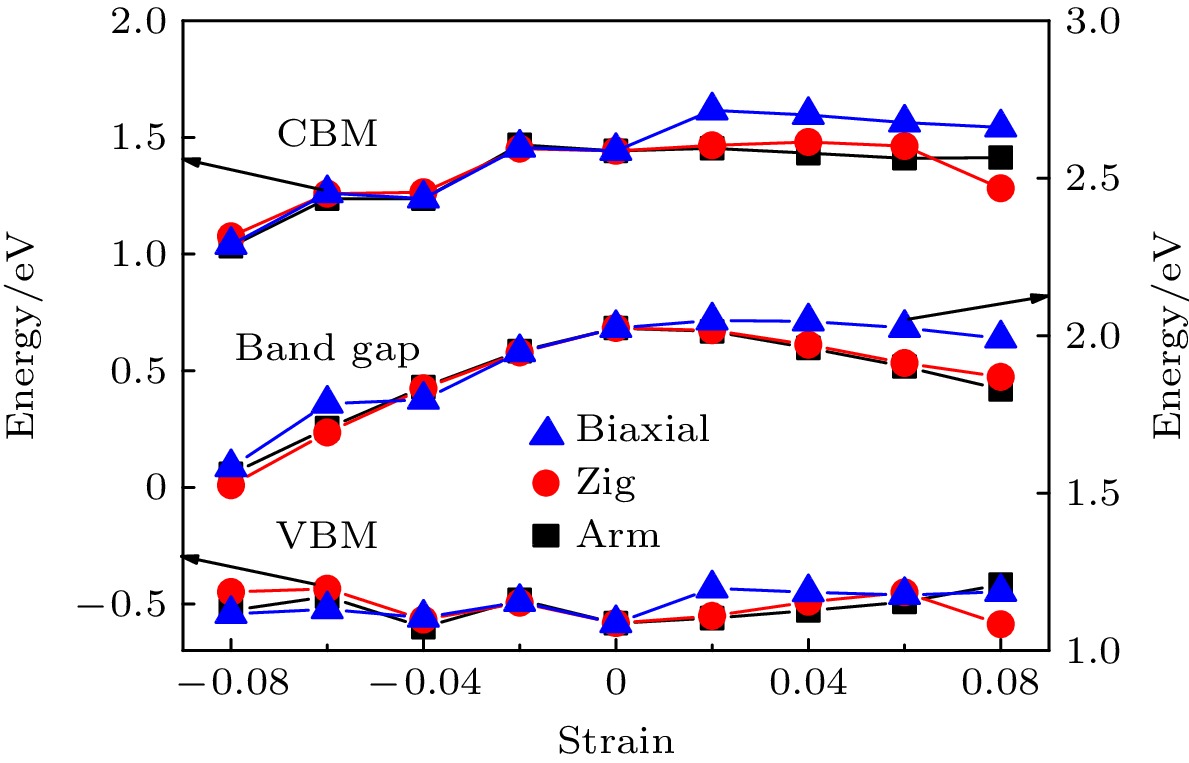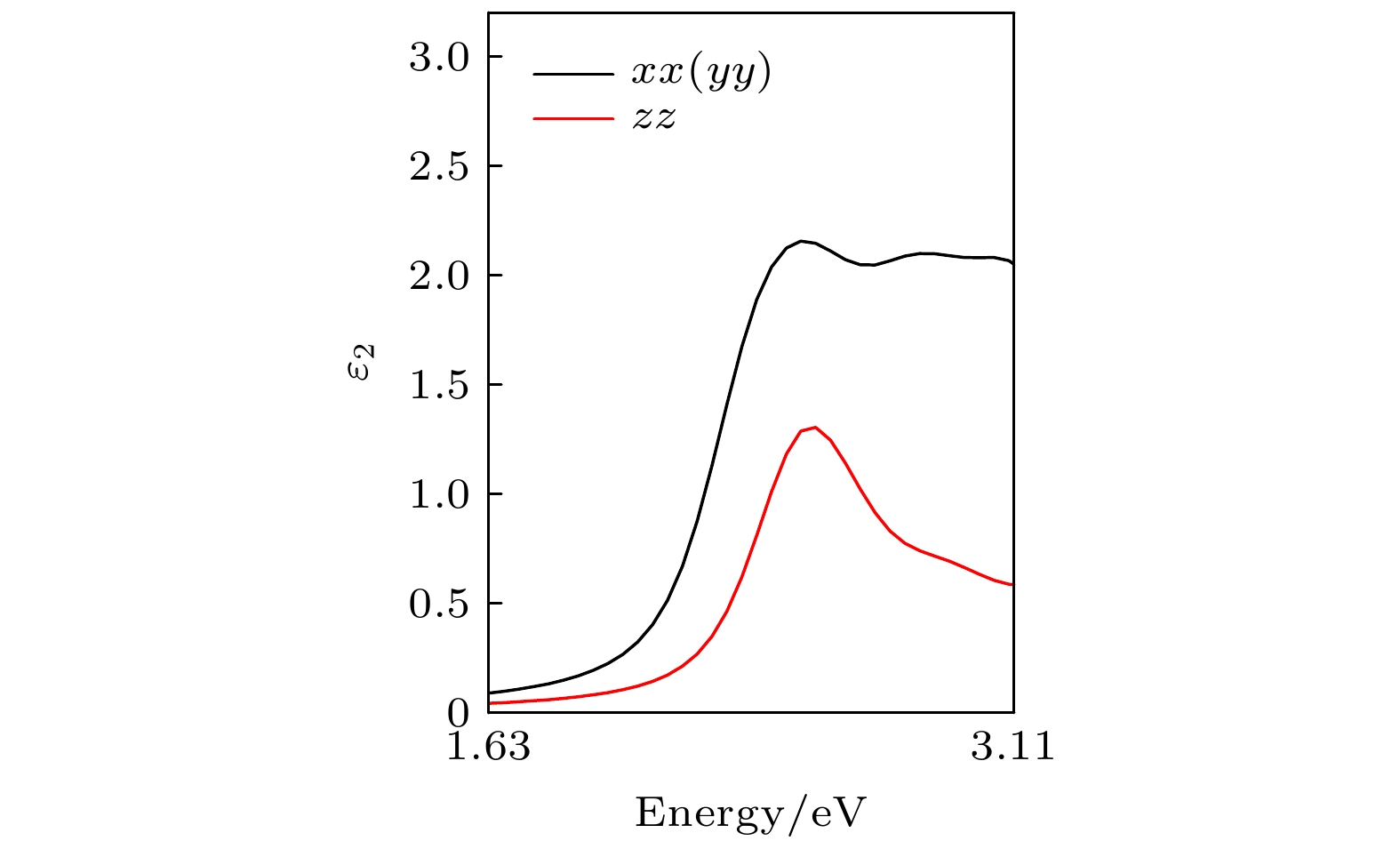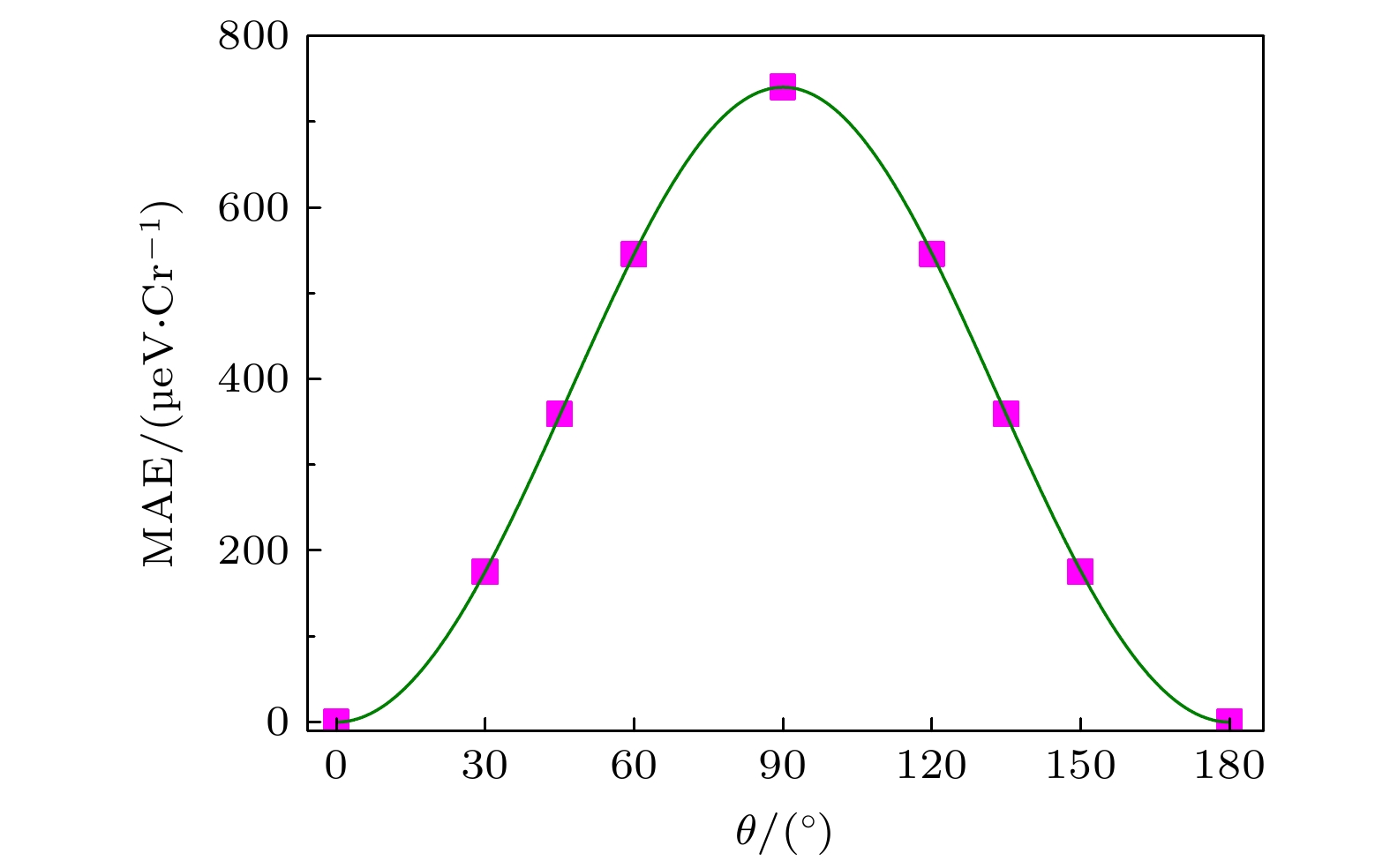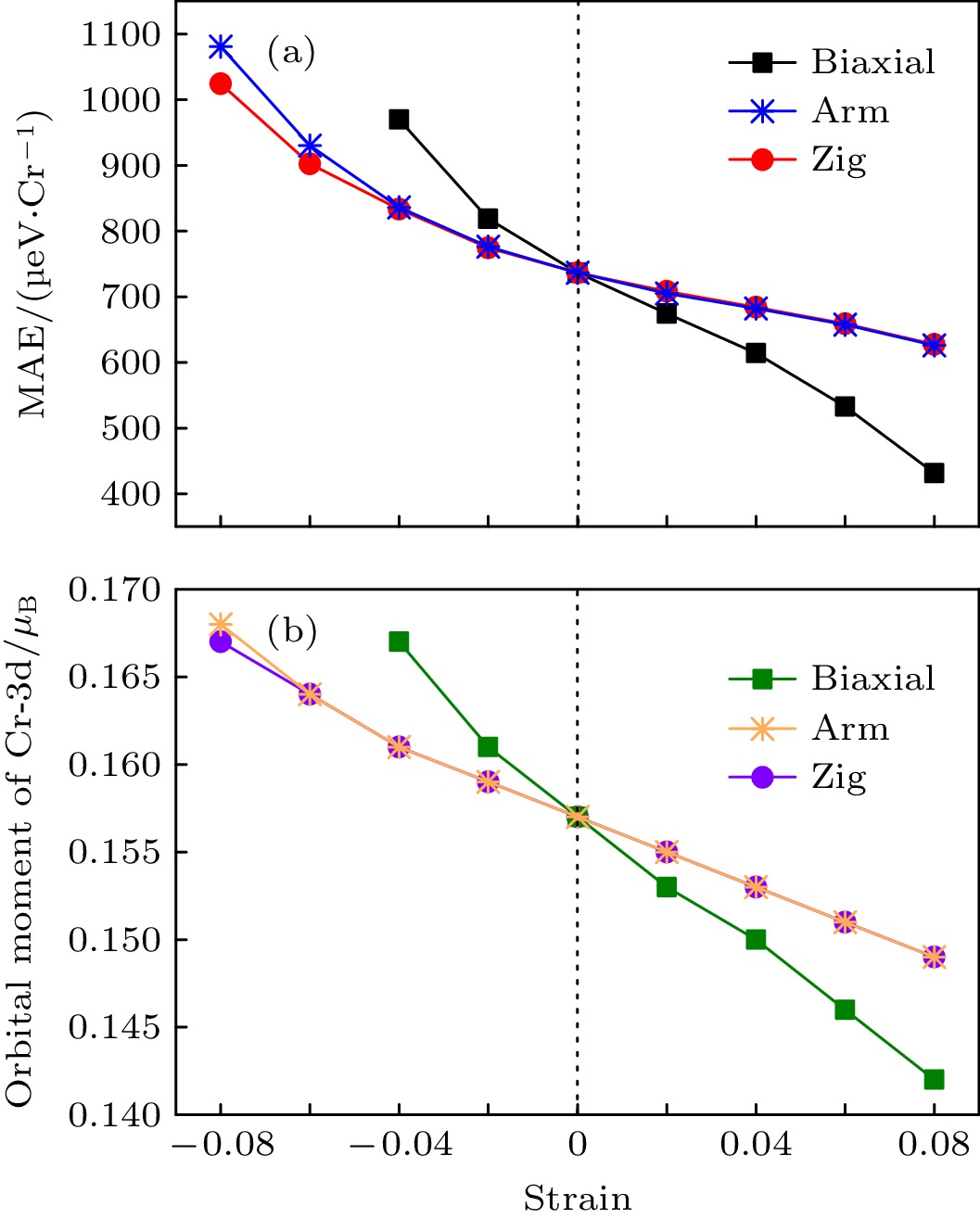-
通过应变调控二维材料的电学性质和光学性质是设计新型二维电子和光电子器件的重要环节, 也是后摩尔时代薄膜器件设计中的关键技术. 薄膜CrI3具有铁磁和层间反铁磁的独特性质, 但是关于应变调制其电学性质和光学性质的研究未见报道. 本文采用高精度杂化密度泛函理论研究了面内单双轴应变对单层CrI3载流子迁移率和介电函数的调控规律, 研究结果与已有的实验和理论值符合较好. 计算发现: 单层CrI3载流子迁移率非常小, 均在10 cm2·V–1·s–1以内; 与拉伸应变相比, 双轴压缩应变可以显著提升迁移率; 当双轴压缩应变量增至8%时, 沿锯齿方向电子迁移率增至174 cm2·V–1·s–1, 达到了MoS2水平. 可见光区介电函数虚部x (y)方向I号吸收峰强度随双轴拉伸应变量增加明显增强, 而z方向几乎没有变化; 可见光区x (y)和z方向的介电函数虚部曲线开始攀升的起点对应的光子能量均随双轴压缩应变量增加明显减小, 且所有吸收峰呈现明显的红移. 结果表明, 应变可以明显提升单层CrI3的电荷输运性能和可见光区的光学性能.Because the single-layer CrI3 is a half semiconductor with indirect band gap and magnetic anisotropy, it has received much attention in the spintronic, magneto-electronic and magnetic storage applications. However, the knowledge of the dependence of carrier mobility and optical property on strain is still rather limited. The uniaxial and biaxial strain dependence of electronic, transport, optical and magnetic properties of single-layer CrI3 are systematically investigated by using first-principles calculations, and the results are compared with experimental results. The electronic structures under different strains are first calculated by using the accurate HSE06 functional, then the carrier mobility is estimated by the deformation potential theory and the dielectric function is obtained to estimate the optical absorption especially in the visible light range. Finally, the magnetic anisotropy energy used to estimate the magneto-electronic properties is studied by the Perdew-Bueke-Ernzerhof functional including the spin-orbit coupling. It is found that the ferromagnetic CrI3 is an indirect and half semiconductor with band gap 2.024 eV,
$ \Delta {\text{CBM}} $ = 1.592 eV,$ \Delta {\text{VBM}} $ = 0.238 eV and can be driven into AF-Néel antiferromagnetic phase by applying –6% to –8% (compressive) biaxial stain, exhibiting excellent agreement with the results from the literature. It is found that of single-layer CrI3 has very low carrier mobility with a value within 10 cm2·V–1·s–1 due to the large effective mass and small in-plane stiffness can be remarkably increased by increasing biaxial compression strain attributed to the reduced effective mass. A high electron mobility 174 cm2·V–1·s–1 is obtained in the zigzag direction by applying a –8% biaxial strain reaching the level of monolayer MoS2. The calculated imaginary component of dielectric function along the x (y) direction having two peaks (I, II) in the visible light range is obviously different from that along the z direction, indicating that the single-layer CrI3 has optical anisotropy, demonstrating the good agreement with results from the literature. It is found that the imaginary part of dielectric function shows that an obvious redshift and peak (I, II) values strongly increase with the increase of compressive strain (biaxial), showing good agreement with the calculated electronic structures and indicating that monolayer CrI3 possesses high optical adsorption of visible light under a compressive biaxial strain. Furthermore, it is found that the magnetic anisotropy energy of monolayer CrI3 mainly stemming from the orbital magnetic moment of Cr ions remarkably increases from 0.7365 to 1.08 meV/Cr with g compressive strain increasing. These results indicate that the optoelectronic property of single-layer CrI3 can be greatly improved by applying biaxial compressive strain and the single-layer CrI3 is a promising material for applications in microelectronic, optoelectronic and magnetic storage.-
Keywords:
- strain /
- first-principles calculations /
- carrier mobility /
- optical properties
[1] Huang B, Clark G, Navarro-Moratalla E, Klein D R, Cheng R, Seyler K L, Zhong D, Schmidgall E, McGuire M A, Cobden D H 2017 Nature 546 270
 Google Scholar
Google Scholar
[2] Gong C, Li L, Li Z L, Ji H W, Stern A, Xia Y, Cao T, Bao W, Wang C Z, Wang Y, Qiu Z Q, Cava R J, Louie S G, Xia J, Zhang X 2017 Nature 546 265
 Google Scholar
Google Scholar
[3] Mermin N D, Wagner H 1966 Phys. Rev. Lett. 17 1133
 Google Scholar
Google Scholar
[4] Sivadas N, Okamoto S, Xu X D, Fennie C J, Xiao D 2018 Nano Lett. 18 7658
 Google Scholar
Google Scholar
[5] Guo G X, Bi G, Cai C F, Wu H Z 2018 J. Phys.: Condens. Matter 30 285303
 Google Scholar
Google Scholar
[6] Webster L, Yan J A 2018 Phys. Rev. B 98 144411
 Google Scholar
Google Scholar
[7] Bacaksiz C, Šabani D, Menezes R M, Milošević M V 2021 Phys. Rev. B 103 125418
 Google Scholar
Google Scholar
[8] Kresse G, Furthmüller J 1996 Phys. Rev. B 54 11169
 Google Scholar
Google Scholar
[9] Baerends E J 1999 Theor. Chem. Acc. 103 265
 Google Scholar
Google Scholar
[10] Wu Z W, Yu J, Yuan S J 2019 Phys. Chem. Chem. Phys. 21 7750
 Google Scholar
Google Scholar
[11] Mukherjee T, Chowdhury S, Jana D, Lew Yan Voon L C 2019 J. Phys.: Condens. Matter 31 335802
 Google Scholar
Google Scholar
[12] Pizzochero M, Yazyev O V 2020 J. Phys. Chem. C 124 7585
[13] Heyd J, Scuseria G E, Ernzerhof M 2003 J. Chem. Phys. 118 8207
 Google Scholar
Google Scholar
[14] Lou B B, Wen J, Cai J J, Yeung Y Y, Yin M, Duan C K 2021 Phys. Rev. B 103 075109
 Google Scholar
Google Scholar
[15] Liu X F, Gao P F, Hu W, Yang J L 2020 J. Phys. Chem. Lett 11 4070
 Google Scholar
Google Scholar
[16] Zhang W B, Qu Q, Zhu P, Lam C H 2015 J. Mater. Chem. C 3 12457
 Google Scholar
Google Scholar
[17] Dillon J F, Olson C E 1965 J. Appl. Phys. 36 1259
 Google Scholar
Google Scholar
[18] Kanazawa K K, Street G B 1970 Phys. Status Solidi B 38 445
 Google Scholar
Google Scholar
[19] Guizzetti G, Nosenzo L, Pollini I, Reguzzoni E, Samoggia G, Spinolo G 1976 Phys. Rev. B 14 4622
 Google Scholar
Google Scholar
[20] Bučko T, Lebègue S, Hafner J, et al. 2013 Phys. Rev. B 87 064110
 Google Scholar
Google Scholar
[21] Larsen A H, Vanin M, Mortensen J J R 2013 Phys. Rev. B 80 2665
 Google Scholar
Google Scholar
[22] Bardeen J, Shockley W 1950 Phys. Rev. 80 72
 Google Scholar
Google Scholar
[23] Vu T V, Nguyen C V, Phuc H V, Lavrentyev A A, Khyzhun O Y, Hieu N V, Obeid M M, Rai D P, Tong H D, Hieu N N 2021 Phys. Rev. B 103 085422
 Google Scholar
Google Scholar
[24] Abboud M, Ozbey D H, Kilic M E, Durgun E 2022 J. Phys. D: Appl. Phys. 55 185302
 Google Scholar
Google Scholar
[25] Perdew J P, Burke K, Ernzerhof M 1996 Phys. Rev. Lett. 77 3865
 Google Scholar
Google Scholar
[26] Monkhorst H J, Pack J D 1976 Phys. Rev. B 13 5188
[27] Sivadas N, Daniels M W, Swendsen R H, Okamoto S, Xiao D 2015 Phys. Rev. B 91 235425
 Google Scholar
Google Scholar
[28] Li P G, Wang C, Zhang J H, Chen S W, Guo D H, Ji W, Zhong D Y 2020 Sci. Bull 65 1064
 Google Scholar
Google Scholar
[29] Vishkayi S I, Torbatian Z, Qaiumzadeh A, Asgari R 2020 Phys. Rev. Mater 4 094004
 Google Scholar
Google Scholar
[30] Hou B W, Zhang Y M, Zhang H, Shao H Z, Ma C C, Zhang X T, Chen Y, Xu K, Ni G, Zhu H Y 2020 J. Phys. Chem. Lett. 11 3116
 Google Scholar
Google Scholar
[31] Zhang D, Hu S, Liu X, Chen Y, Xia Y, Wang H, Wang H, Ni Y 2020 ACS Appl. Energy Mater 4 357
[32] Cadelano E, Palla P L, Giordano S, Colombo L 2010 Phys. Rev. B 82 235414
 Google Scholar
Google Scholar
[33] Liu J Y, Sun Q, Kawazoe Y, Jena P 2016 Phys. Chem. Chem. Phys 18 8777
 Google Scholar
Google Scholar
[34] Mak K F, Lee C, Hone J, Shan J, Heinz T F 2010 Phys. Rev. Lett. 105 136805
 Google Scholar
Google Scholar
[35] Cai YQ, Zhang G, Zhang Y W 2014 J. Am. Chem. Soc. 136 6269
 Google Scholar
Google Scholar
[36] Xu L, Yang M, Wang S J, Feng Y P 2017 Phys. Rev. B 95 235434
 Google Scholar
Google Scholar
[37] Komsa H P, Krasheninnikov A V 2013 Phys. Rev. B 88 085318
 Google Scholar
Google Scholar
[38] Lu R F, Li F, Salafranca J, Kan E J, Xiao C Y, Deng K M 2014 Phys. Chem. Chem. Phys. 16 4299
 Google Scholar
Google Scholar
[39] Prokop J, Kukunin A, Elmers H J 2005 Phys. Rev. Lett. 95 187202
 Google Scholar
Google Scholar
[40] Nguyen T P T, Yamauchi K, Nakamura K, Oguchi T 2020 J. Phys. Soc. Japan 89 114710
 Google Scholar
Google Scholar
[41] Zhuang H L L, Kent P R C, Hennig R G 2016 Phys. Rev. B 93 134407
 Google Scholar
Google Scholar
[42] Zhang J M, Yang B S, Zheng H L, Han X F, Yan Y 2017 Phys. Chem. Chem. Phys. 19 24341
 Google Scholar
Google Scholar
[43] Ma X F, Yin L, Zou J J, Mi W B, Wang X C 2019 J. Phys. Chem. C 123 17440
 Google Scholar
Google Scholar
-
表 1 单层CrI3电子和空穴沿x (y)方向的物理参数
Table 1. Physical parameters of electron and hole of CrI3 monolayer in x (y) direction, respectively.
Carrier Direction m*/m0 md/m0 Ed/eV C2D/(N·m–1) μ/(cm2·V–1·s–1) Electron x 5.45 5.79 2.29 25.5 3.26 y 6.15 2.25 24.5 2.84 Hole x –2.57 2.32 3.87 25.5 6.05 y –2.10 4.01 24.5 6.63 表 2 双轴应变下单层CrI3电子和空穴沿x (y)方向的有效质量m*和迁移率μ
Table 2. The biaxial strain dependence of the effective mass m* and carrier mobility μ of electron and hole of CrI3 monolayer in x (y) direction, respectively.
Strain m*/(m0μ)/(cm2·V–1·s–1) Electron Hole Electron Hole $ m_x^* $ $ m_y^* $ $ m_x^* $ $ m_y^* $ μx μy μx μy 0.08 8.82 10.122 –1.682 –1.652 1.21 1.11 12.80 11.68 0.06 6.42 8.540 –1.79 –1.740 2.18 1.66 11.37 10.46 0.04 6.15 7.640 –2.15 –1.900 2.42 1.89 8.28 8.37 0.02 6.78 6.780 –2.098 –1.858 2.24 2.21 8.74 8.84 0 5.45 6.150 –2.57 –2.100 3.26 2.84 6.05 6.63 –0.02 1.90 1.940 –1.45 –1.410 28.17 27.54 17.37 16.00 –0.04 0.98 1.180 –1.48 –1.510 98.16 80.48 16.25 14.24 –0.06 1.02 1.050 –0.84 –1.040 97.56 94.28 45.84 33.31 –0.08 0.71 0.970 –0.78 –0.920 173.53 126.24 54.29 41.06 -
[1] Huang B, Clark G, Navarro-Moratalla E, Klein D R, Cheng R, Seyler K L, Zhong D, Schmidgall E, McGuire M A, Cobden D H 2017 Nature 546 270
 Google Scholar
Google Scholar
[2] Gong C, Li L, Li Z L, Ji H W, Stern A, Xia Y, Cao T, Bao W, Wang C Z, Wang Y, Qiu Z Q, Cava R J, Louie S G, Xia J, Zhang X 2017 Nature 546 265
 Google Scholar
Google Scholar
[3] Mermin N D, Wagner H 1966 Phys. Rev. Lett. 17 1133
 Google Scholar
Google Scholar
[4] Sivadas N, Okamoto S, Xu X D, Fennie C J, Xiao D 2018 Nano Lett. 18 7658
 Google Scholar
Google Scholar
[5] Guo G X, Bi G, Cai C F, Wu H Z 2018 J. Phys.: Condens. Matter 30 285303
 Google Scholar
Google Scholar
[6] Webster L, Yan J A 2018 Phys. Rev. B 98 144411
 Google Scholar
Google Scholar
[7] Bacaksiz C, Šabani D, Menezes R M, Milošević M V 2021 Phys. Rev. B 103 125418
 Google Scholar
Google Scholar
[8] Kresse G, Furthmüller J 1996 Phys. Rev. B 54 11169
 Google Scholar
Google Scholar
[9] Baerends E J 1999 Theor. Chem. Acc. 103 265
 Google Scholar
Google Scholar
[10] Wu Z W, Yu J, Yuan S J 2019 Phys. Chem. Chem. Phys. 21 7750
 Google Scholar
Google Scholar
[11] Mukherjee T, Chowdhury S, Jana D, Lew Yan Voon L C 2019 J. Phys.: Condens. Matter 31 335802
 Google Scholar
Google Scholar
[12] Pizzochero M, Yazyev O V 2020 J. Phys. Chem. C 124 7585
[13] Heyd J, Scuseria G E, Ernzerhof M 2003 J. Chem. Phys. 118 8207
 Google Scholar
Google Scholar
[14] Lou B B, Wen J, Cai J J, Yeung Y Y, Yin M, Duan C K 2021 Phys. Rev. B 103 075109
 Google Scholar
Google Scholar
[15] Liu X F, Gao P F, Hu W, Yang J L 2020 J. Phys. Chem. Lett 11 4070
 Google Scholar
Google Scholar
[16] Zhang W B, Qu Q, Zhu P, Lam C H 2015 J. Mater. Chem. C 3 12457
 Google Scholar
Google Scholar
[17] Dillon J F, Olson C E 1965 J. Appl. Phys. 36 1259
 Google Scholar
Google Scholar
[18] Kanazawa K K, Street G B 1970 Phys. Status Solidi B 38 445
 Google Scholar
Google Scholar
[19] Guizzetti G, Nosenzo L, Pollini I, Reguzzoni E, Samoggia G, Spinolo G 1976 Phys. Rev. B 14 4622
 Google Scholar
Google Scholar
[20] Bučko T, Lebègue S, Hafner J, et al. 2013 Phys. Rev. B 87 064110
 Google Scholar
Google Scholar
[21] Larsen A H, Vanin M, Mortensen J J R 2013 Phys. Rev. B 80 2665
 Google Scholar
Google Scholar
[22] Bardeen J, Shockley W 1950 Phys. Rev. 80 72
 Google Scholar
Google Scholar
[23] Vu T V, Nguyen C V, Phuc H V, Lavrentyev A A, Khyzhun O Y, Hieu N V, Obeid M M, Rai D P, Tong H D, Hieu N N 2021 Phys. Rev. B 103 085422
 Google Scholar
Google Scholar
[24] Abboud M, Ozbey D H, Kilic M E, Durgun E 2022 J. Phys. D: Appl. Phys. 55 185302
 Google Scholar
Google Scholar
[25] Perdew J P, Burke K, Ernzerhof M 1996 Phys. Rev. Lett. 77 3865
 Google Scholar
Google Scholar
[26] Monkhorst H J, Pack J D 1976 Phys. Rev. B 13 5188
[27] Sivadas N, Daniels M W, Swendsen R H, Okamoto S, Xiao D 2015 Phys. Rev. B 91 235425
 Google Scholar
Google Scholar
[28] Li P G, Wang C, Zhang J H, Chen S W, Guo D H, Ji W, Zhong D Y 2020 Sci. Bull 65 1064
 Google Scholar
Google Scholar
[29] Vishkayi S I, Torbatian Z, Qaiumzadeh A, Asgari R 2020 Phys. Rev. Mater 4 094004
 Google Scholar
Google Scholar
[30] Hou B W, Zhang Y M, Zhang H, Shao H Z, Ma C C, Zhang X T, Chen Y, Xu K, Ni G, Zhu H Y 2020 J. Phys. Chem. Lett. 11 3116
 Google Scholar
Google Scholar
[31] Zhang D, Hu S, Liu X, Chen Y, Xia Y, Wang H, Wang H, Ni Y 2020 ACS Appl. Energy Mater 4 357
[32] Cadelano E, Palla P L, Giordano S, Colombo L 2010 Phys. Rev. B 82 235414
 Google Scholar
Google Scholar
[33] Liu J Y, Sun Q, Kawazoe Y, Jena P 2016 Phys. Chem. Chem. Phys 18 8777
 Google Scholar
Google Scholar
[34] Mak K F, Lee C, Hone J, Shan J, Heinz T F 2010 Phys. Rev. Lett. 105 136805
 Google Scholar
Google Scholar
[35] Cai YQ, Zhang G, Zhang Y W 2014 J. Am. Chem. Soc. 136 6269
 Google Scholar
Google Scholar
[36] Xu L, Yang M, Wang S J, Feng Y P 2017 Phys. Rev. B 95 235434
 Google Scholar
Google Scholar
[37] Komsa H P, Krasheninnikov A V 2013 Phys. Rev. B 88 085318
 Google Scholar
Google Scholar
[38] Lu R F, Li F, Salafranca J, Kan E J, Xiao C Y, Deng K M 2014 Phys. Chem. Chem. Phys. 16 4299
 Google Scholar
Google Scholar
[39] Prokop J, Kukunin A, Elmers H J 2005 Phys. Rev. Lett. 95 187202
 Google Scholar
Google Scholar
[40] Nguyen T P T, Yamauchi K, Nakamura K, Oguchi T 2020 J. Phys. Soc. Japan 89 114710
 Google Scholar
Google Scholar
[41] Zhuang H L L, Kent P R C, Hennig R G 2016 Phys. Rev. B 93 134407
 Google Scholar
Google Scholar
[42] Zhang J M, Yang B S, Zheng H L, Han X F, Yan Y 2017 Phys. Chem. Chem. Phys. 19 24341
 Google Scholar
Google Scholar
[43] Ma X F, Yin L, Zou J J, Mi W B, Wang X C 2019 J. Phys. Chem. C 123 17440
 Google Scholar
Google Scholar
计量
- 文章访问数: 8122
- PDF下载量: 215
- 被引次数: 0

















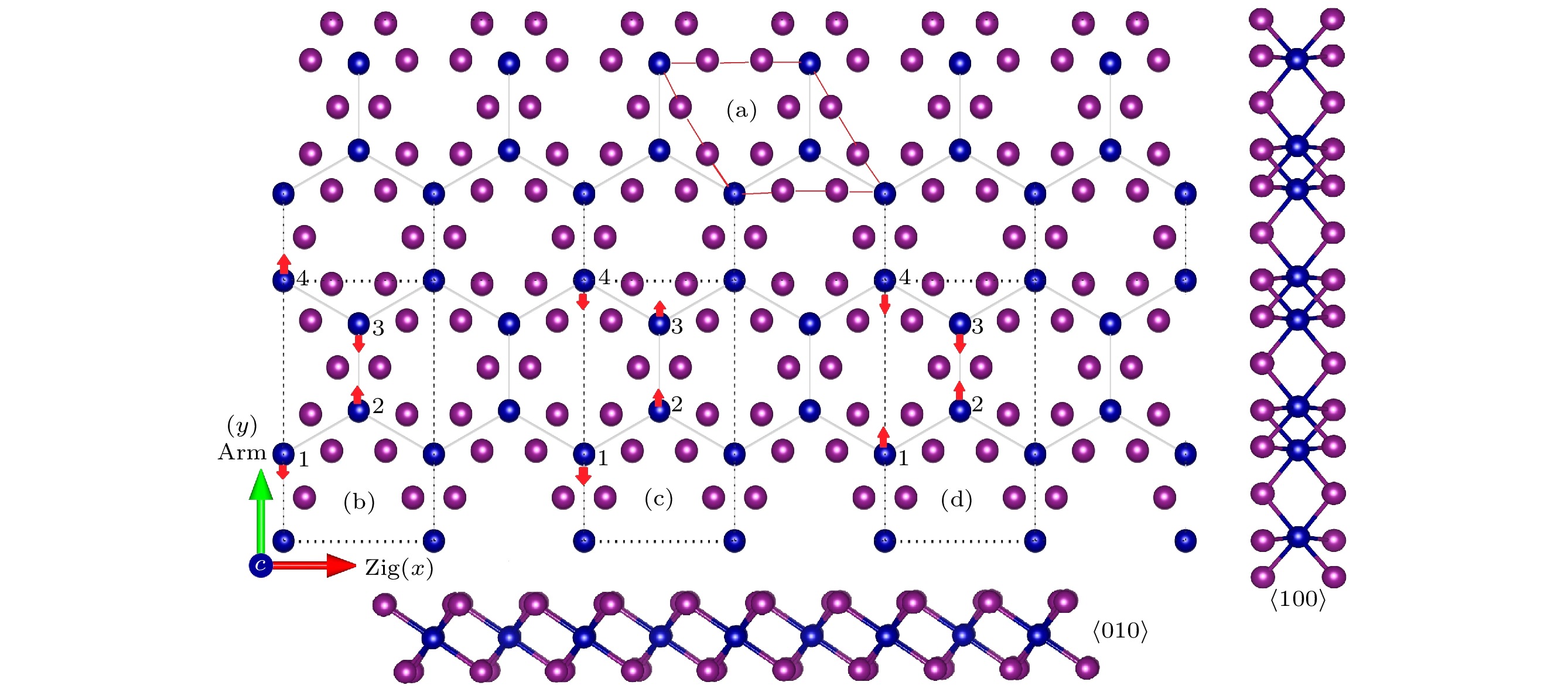
 下载:
下载:



